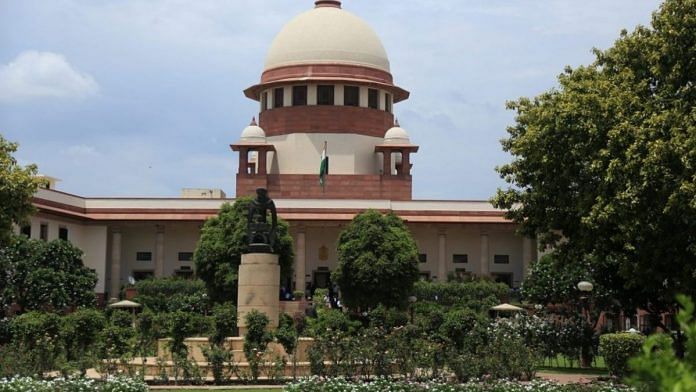New Delhi: The NITI Aayog has commissioned a study that will examine the economic impact of Supreme Court and National Green Tribunal judgments, including those that have a negative impact, ThePrint has learnt.
According to sources in the NITI Aayog, the study was commissioned to CUTS (Consumer Unity and Trust Society) International a year and a half ago, and is meant to ascertain whether a framework can be created to gauge the impact of Supreme Court judgments. However, CUTS began groundwork on this study only in November 2020, as a result of delays caused due to the Covid-19 pandemic.
“The study is meant to carry out a cost-benefit analysis of SC judgments, and see if there are any unintended economic consequences of judgments,” an official said on condition of anonymity.
“A lot of times, committees are made by the Supreme Court, so it is important to know what these committees end up accomplishing, what deadlines they follow, if there are any delays caused or not… The study does not assume or believe that there is any judicial overreach,” the official clarified.
For the purpose of this study, five cases have been picked. Three of them are Supreme Court judgments — on the construction of an airport in Mopa, Goa; cessation of iron ore mining in Goa; and the shutting down of the Sterlite copper plant in Thoothukudi, Tamil Nadu — while two decided by the NGT are on sand mining ban and halt on construction activities in Delhi-NCR.
Also read: NITI Aayog plans new expert groups that will act as ‘bridge between govt and civil society’
CUTS’ brief
A study brief posted by CUTS, which was later taken down, said: “Judicial decisions have far-reaching economic impacts which are often not taken into account at the time of decision-making. Some of the recent judgments/orders of the Supreme Court and the National Green Tribunal (NGT) indicate that the economic impact analysis of judicial decisions is yet to gain broader acceptance.”
Taking note of ‘judicial activism’, the brief noted: “The absence of ex-ante analysis of the economic costs associated with a decision is further exacerbated when judicial activism by courts and tribunals is also at play.”
It added that there is a need to estimate the economic impacts of judicial decisions through a “structured and systematic process”, which would allow for a discourse to broaden the considerations of the courts while taking decisions.
“The judiciary needs to take into account environment, equity and economic considerations while deciding cases, and needs to institutionalise a mechanism for it,” it stated. “In parallel, there is a need to create a public discourse among key policymakers, members of the judiciary, and academia for promoting a responsible approach by the judiciary while deciding cases.”
However, the NITI Aayog clarified to CUTS that the purpose of the study is not to imply ‘judicial activism’, as its brief stated. An official said the government’s policy think-tank told CUTS: “The study is to be an objective cost-benefit analysis to holistically examine the economic impact, if any, of these judgments.”
Why it’s necessary
In the project brief, CUTS took note of a 2017 Supreme Court judgment by Justice A.K. Sikri and Justice A.M. Sapre (both now retired), in which the apex court said the Indian judiciary must consider the impact of its judgments on the economy, jobs, etc.
“The court needs to avoid that particular outcome which has a potential to create an adverse effect on employment, growth of infrastructure or economy, or the revenue of the state,” the judgment said.
In 2019, senior lawyer Harish Salve said he squarely blamed the Supreme Court of India for some of the problems ailing the economy. As reported by ThePrint earlier, several Supreme Court judgments — cancellation of the 2G spectrum licences, coal block allotments, mining leases in Goa, and the court’s foray into policy-making through orders such as the highway liquor ban — corroborate his claim.
Speaking to ThePrint, former steel secretary Aruna Sharma also said the study is extremely necessary.
“In the Supreme Court, two different parties often discuss the legalities of an issue. The economic impact is seldom factored in,” she said.
Speaking about one of the cases being studied, the cessation of iron ore mining in Goa, Sharma said: “In 2018, all iron ore mining stopped in Goa because of this judgment. This is in a state where one out of five people are directly or indirectly associated with iron ore mining. The state with one of the highest per capita incomes has become a state with one of the lowest, and even the state government is left borrowing.”
She added: “It is nobody’s case that the Supreme Court is to be blamed for such cases, but we do need a mechanism wherein in such cases, the socio-economic impact of a case can be brought in front of the court before it makes a judgment.”
Also read: Niti Aayog at 6 — some ideas too ‘ambitious’ but Modi think tank has many reforms up its sleeve







Someone has to complete this study and post it to all HCs and SC and NGT. Too much envi activism. The envi activism of the west simply can’t be afforded by India.